7 Best Eco-Friendly Safari Lodges in Asia for Nature Lovers
I still remember the first time I stayed in an eco-friendly safari lodge. It was in the heart of Borneo, where mist curled over the rainforest at dawn, and I woke up to the distant calls of gibbons. The experience changed the way I travel. I wasn’t just a visitor—I was part of something bigger, a place where conservation and comfort went hand in hand.
Asia is home to some of the most biodiverse places on Earth. However, deforestation and habitat loss threaten wildlife, making sustainable tourism more important. That’s why I seek out eco-friendly safari lodges—places that protect nature while offering an unforgettable stay. These lodges use solar power, rainwater harvesting, and local materials, ensuring that travelers like us can enjoy the wild without harming it.
Suppose you’re looking for a meaningful adventure. In that case, I’ve found seven of the best eco-lodges in Asia where you can wake up to the sounds of nature and leave with more than just memories.
7 Best Eco-Friendly Safari Lodges in Asia
I’ve stayed in some incredible places, but these eco-lodges stand out for their beauty and their respect for and protection of the environment. They prove that you don’t have to sacrifice comfort to travel sustainably.
1. Sukau Rainforest Lodge (Malaysia)

In Borneo’s Kinabatangan River, Sukau Rainforest Lodge feels like a hidden world. I remember gliding down the river at sunrise, mist hovering above the water, as a family of pygmy elephants drank along the banks. Proboscis monkeys leaped from branch to branch in the trees while hornbills soared overhead.
Sukau Rainforest Lodge is one of Malaysia’s most eco-conscious lodges. It runs on solar energy, harvests rainwater, and eliminates single-use plastics. The entire lodge is built on stilts to protect the delicate river ecosystem.
What makes it special? The wildlife experiences are unreal. River safaris replace noisy jeeps, allowing you to drift quietly through one of Borneo’s richest ecosystems. At night, the jungle comes alive with sounds—frogs, insects, and the occasional distant call of a Bornean orangutan.
- Eco-Friendly Highlights: Solar power, rainwater harvesting, plastic-free initiatives
- Wildlife Encounters: Pygmy elephants, proboscis monkeys, orangutans, crocodiles, and hornbills
- Best Time to Visit: March to October (dry season for best wildlife viewing)
2. Tiger Tops Tharu Lodge (Nepal)
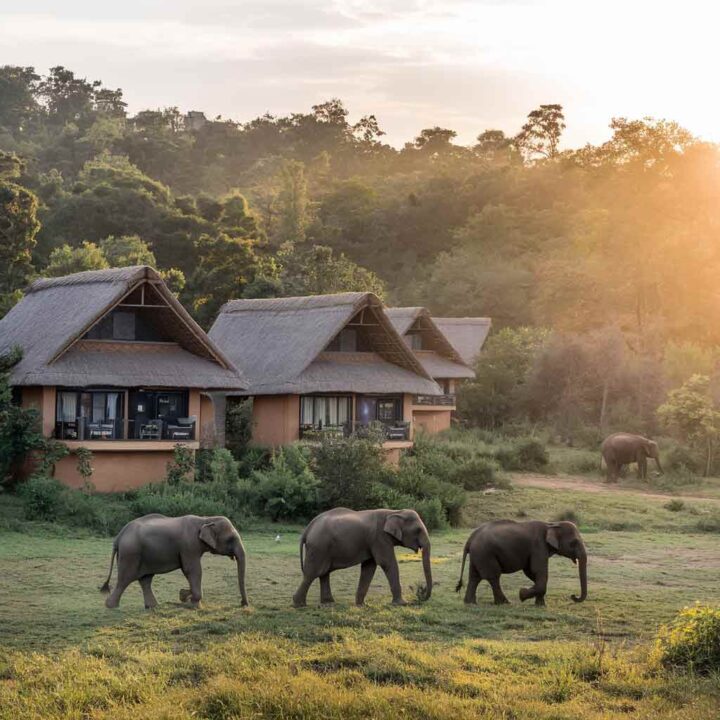
I never thought I’d find myself walking barefoot in the soft mud alongside an elephant through the jungles of Nepal. But at Tiger Tops Tharu Lodge, that’s exactly what I did. And unlike traditional elephant rides, this experience was ethical—the elephants walked freely, with no chains, no saddles, just their natural instincts leading the way.
Nestled near Chitwan National Park, this lodge is a leader in responsible tourism. It was among the first to stop elephant-back safaris and replace them with elephant walks and jungle treks, during which you respectfully observe the animals.
The lodge uses traditional Tharu materials, blending seamlessly into the landscape. Solar panels provide electricity, and the organic farm supplies fresh produce for meals. Even the swimming pool is chemical-free, using natural filtration methods.
What makes it special is its commitment to ethical animal tourism. Instead of exploiting elephants, Tiger Tops focuses on their well-being, allowing visitors to experience them in a way that respects their natural behavior.
- Eco-Friendly Highlights: Solar power, organic farm-to-table dining, sustainable architecture
- Wildlife Encounters: Bengal tigers, one-horned rhinos, wild elephants, and gharial crocodiles
- Best Time to Visit: October to March (cooler weather, better wildlife sightings)
3. Cardamom Tented Camp (Cambodia)
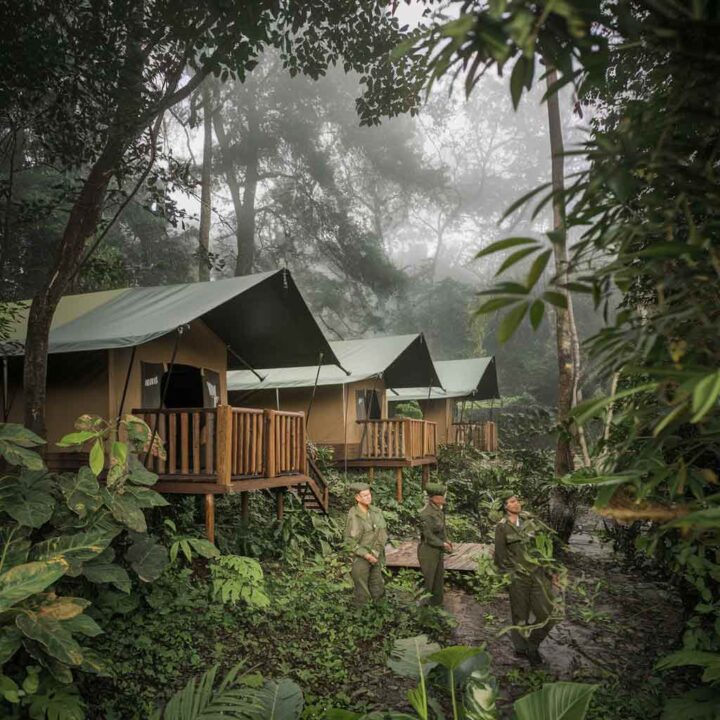
“Your Stay Keeps the Forest Standing.” That’s the motto at Cardamom Tented Camp, and they mean it. Nestled in Cambodia’s Cardamom Rainforest, one of Southeast Asia’s last unbroken wilderness areas, this eco-lodge is more than just a place to sleep—it’s part of a mission to protect wildlife from poaching and deforestation.
I arrived by boat, gliding down the Preak Tachan River, surrounded by dense jungle and the occasional splash of a fish. The camp itself blends into the landscape—just nine safari-style tents, each with a simple but comfortable setup, solar-powered lights, and an open-air dining area where guests swap stories over locally sourced meals.
What sets this place apart is the chance to join forest rangers on patrol. Trekking through the jungle, I spotted fresh tracks—wild elephants had passed through just hours before. We didn’t see them, but we did find evidence of snares set by poachers. The rangers removed them, a stark reminder of this rainforest’s threats.
If you’re looking for a place where your visit makes a real difference, this is it. Every stay directly supports conservation efforts, helping to fund anti-poaching teams that protect clouded leopards, sun bears, and pangolins—some of the region’s most endangered species.
- Eco-Friendly Highlights: Fully solar-powered, no single-use plastics, supports ranger-led conservation
- Wildlife Encounters: Wild elephants, clouded leopards, gibbons, hornbills, and pangolins
- Best Time to Visit: November to April (dry season, best for trekking and wildlife spotting)
4. Gal Oya Lodge (Sri Lanka)
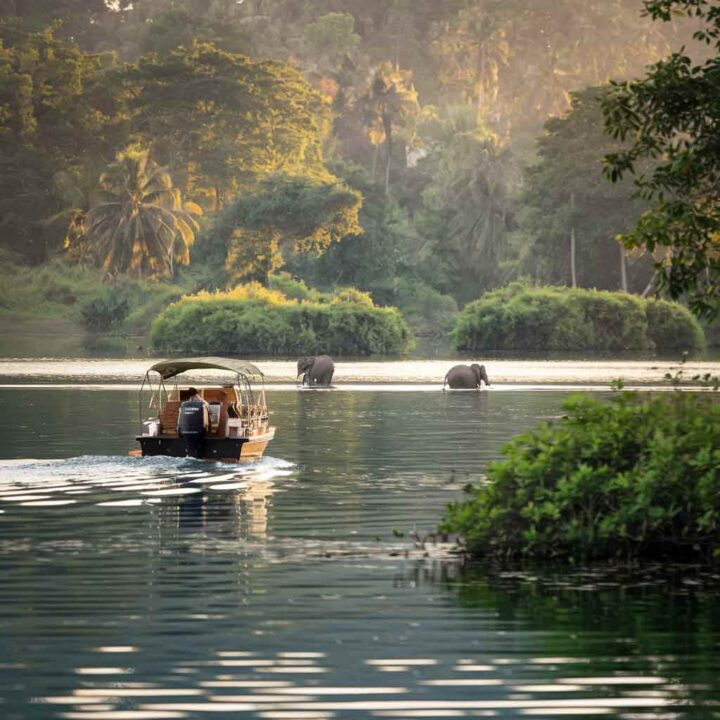
I never expected to see elephants swimming between islands, but that’s exactly what happens in Sri Lanka’s Gal Oya National Park. It’s one of the only places in the world where you can take a boat safari and watch herds of wild elephants wading through the water.
Gal Oya Lodge is built on 20 acres of private jungle, with just 10 thatched-roof bungalows that feel like an extension of the landscape. The architecture is stunning—walls made of local stone, palm-thatched roofs, and large windows that let in the sounds of the rainforest. There’s no WiFi in the rooms, but you won’t miss it. The real connection here is with nature.
One of the most unique experiences was walking with the Vedda tribe, Sri Lanka’s last indigenous forest people. I followed their chief through the jungle as he pointed out medicinal plants, ancient hunting grounds, and hidden waterholes. It was a rare and humbling insight into a way of life that’s disappearing fast.
Gal Oya Lodge isn’t just about wildlife—it’s also about culture, conservation, and slowing down. You wake up to birdsong, spend your days exploring by boat or on foot, and end your evenings under a canopy of stars.
- Eco-Friendly Highlights: Built with sustainable local materials, solar-powered water heating supports Indigenous communities.
- Wildlife Encounters: Swimming elephants, leopards, crocodiles, and over 150 bird species
- Best Time to Visit: February to September (best for boat safaris and wildlife activity)
5. Samode Safari Lodge (India)
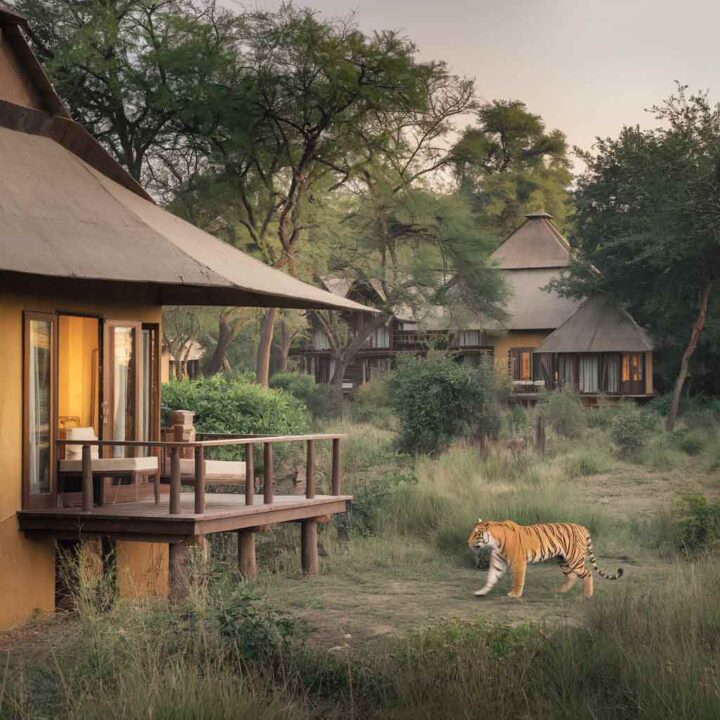
There’s something magical about how dawn breaks over Bandhavgarh National Park—mist rising from the meadows, deer moving through golden light, and a distant tiger’s deep, echoing call. Samode Safari Lodge, set on the park’s edge, gives you front-row seats to one of India’s richest wildlife reserves.
I stayed here during peak tiger season, and during the first safari, I saw a massive male Bengal tiger lazily stretching in the grass. It was one of those moments that sent shivers down my spine. But what makes Samode special isn’t just the wildlife—it’s how the lodge blends luxury with sustainability.
Each of the 12 villas is inspired by traditional village homes but built with locally sourced materials to reduce environmental impact. They use solar power for electricity, treat their wastewater, and grow organic produce on-site for their restaurant. Even their game drives focus on ethical tourism—only experienced guides lead safaris, ensuring minimal animal disturbance.
Evenings at the lodge are something else. After a day in the jungle, you can soak in a sunken bathtub, dine under the stars, or sit by the fire pit, listening to the sounds of the wild. It’s sustainable luxury at its best—a place where you don’t just watch nature, you feel part of it.
- Eco-Friendly Highlights: Solar-powered, locally sourced materials, organic farm-to-table dining
- Wildlife Encounters: Bengal tigers, leopards, sloth bears, and over 250 bird species
- Best Time to Visit: October to June (March to May is best for tiger sightings)
6. Waghoba Eco Lodge (India)
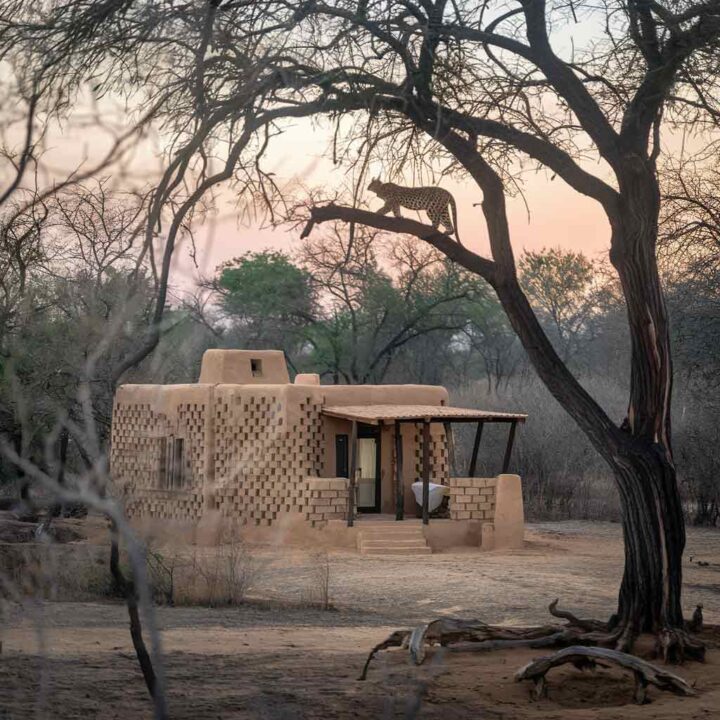
Tadoba National Park is one of India’s best-kept secrets. In this lesser-known tiger haven, you can experience the wild without the crowds. Nestled just outside its gates, Waghoba Eco Lodge is redefining what it means to be an eco-friendly safari stay.
The first thing that struck me was the architecture. The cottages are built using handmade adobe bricks, keeping interiors naturally cool without the need for air conditioning. More than 50% of the lodge’s power comes from solar energy, and a rainwater-fed pond helps support local biodiversity. Even the swimming pool is eco-friendly—no chlorine, just natural filtration.
But it’s the safaris that make this place special. Tadoba is home to one of the highest densities of tigers in India, and game drives here feel intimate and raw. On my second day, we came face-to-face with a mother tiger and her cubs—an experience I’ll never forget.
What sets Waghoba apart is its deep connection to the land. The lodge employs local communities, supports reforestation projects, and ensures that its guests understand the ecosystem’s delicate balance. It’s a place where sustainability isn’t an afterthought—it’s the foundation of everything they do.
- Eco-Friendly Highlights: Solar-powered, rainwater harvesting, natural cooling architecture
- Wildlife Encounters: Bengal tigers, leopards, wild dogs, sloth bears
- Best Time to Visit: February to May (for the best tiger sightings)
7. Borneo Rainforest Lodge (Malaysia)
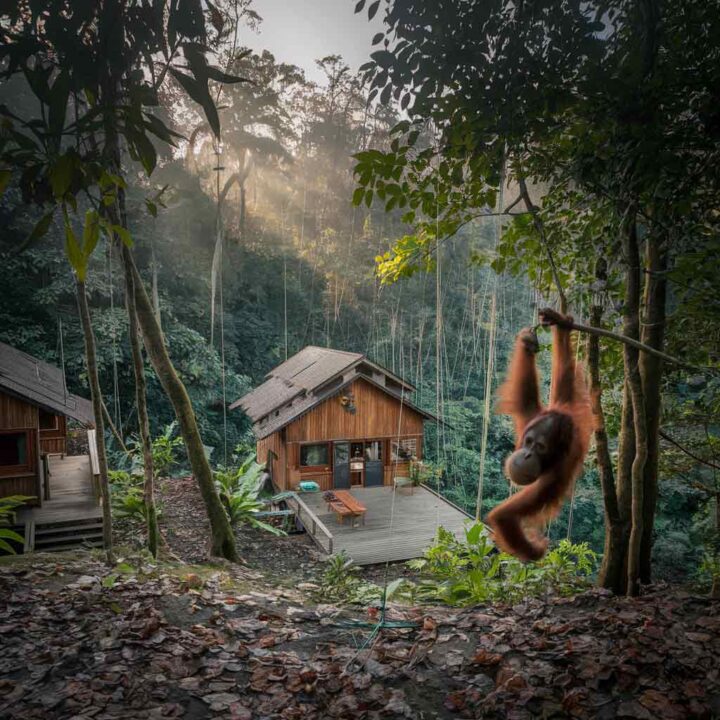
Some places change you, and Borneo Rainforest Lodge is one of them. Tucked deep within Danum Valley, one of the last untouched rainforests in Borneo, this eco-lodge offers an experience so wild and immersive that it feels like stepping into a primal world.
Here, the jungle hums with life. Within minutes of arriving, I saw a red-leaf monkey swinging through the trees. Later, on a guided night walk, I spotted a slow loris, its huge eyes glowing under the moonlight. And just before dawn, we heard the distant call of an orangutan echoing through the canopy.
The lodge itself is built with sustainability in mind. Raised wooden chalets blend seamlessly into the jungle, solar panels provide power, and everything—down to the bathroom soap—is biodegradable. They even limit electricity use during certain hours to reduce their footprint.
But what makes this place truly special is its dedication to conservation and research. The Danum Valley Research Center is nearby, and scientists regularly study the area’s endangered species. Staying here means directly contributing to the protection of Borneo’s incredible biodiversity.
If you want to experience a rainforest in its purest form, this is the place to do it. You’ll leave with muddy boots, incredible memories, and a deeper appreciation for the wild.
- Eco-Friendly Highlights: Solar power, biodegradable products, supports rainforest research
- Wildlife Encounters: Orangutans, pygmy elephants, clouded leopards, and flying squirrels
- Best Time to Visit: March to October (for drier weather, though it’s a rainforest, so expect rain anytime)
Criteria for Choosing the Best Eco-Friendly Safari Lodges in Asia
Not all lodges that call themselves “eco-friendly” actually are. I’ve learned this the hard way—staying at places that claimed to be sustainable but did little beyond skipping plastic straws. If you want to make sure your safari stay is truly eco-conscious.

1. Conservation Efforts
A real eco-lodge doesn’t just exist in nature—it protects it. This means it actively contributes to conservation projects, whether anti-poaching, reforestation, or supporting wildlife research. Lodges near protected reserves often have partnerships with national parks, which helps fund preservation work.
2. Sustainable Energy & Water Use
The best eco-lodges run on renewable energy like solar or wind. They also minimize water waste using rainwater harvesting and eco-friendly filtration systems instead of relying on overdrawn local resources. Some even have biodegradable wastewater treatment systems to prevent pollution.
3. Local & Ethical Community Involvement
Sustainability isn’t just about nature—it’s about people, too. Look for lodges that employ and empower local communities, sourcing food, crafts, and labor locally. Some of the best places offer cultural experiences, such as guided village visits, local cooking classes, or interactions with indigenous tribes.
4. Eco-Friendly Building Design
Sustainable lodges don’t harm the landscape around them. The best ones use natural or recycled materials, avoid cutting down trees unnecessarily, and blend into their surroundings. Some use passive cooling techniques instead of energy-heavy air conditioning, keeping rooms cool with smart ventilation.
5. Wildlife-Friendly Policies
This is a big one. A truly ethical lodge does not support animal exploitation—no captive wildlife for tourist entertainment, no unethical elephant rides, no staged animal encounters. Instead, it promotes responsible wildlife viewing, ensuring that animals are observed without disturbance and in their natural habitat.
When choosing an eco-lodge, I always ask myself: Is this place giving back to nature or just taking from it? If it’s not actively doing good, it’s not really eco-friendly.
Why Choose an Eco-Friendly Safari Lodge?
I used to think safari travel was automatically good for conservation—until I saw the damage mass tourism can cause. The truth is that not all safari experiences help the environment. Some exploit animals, overuse resources, or disrupt fragile ecosystems. That’s why choosing an eco-friendly lodge matters.
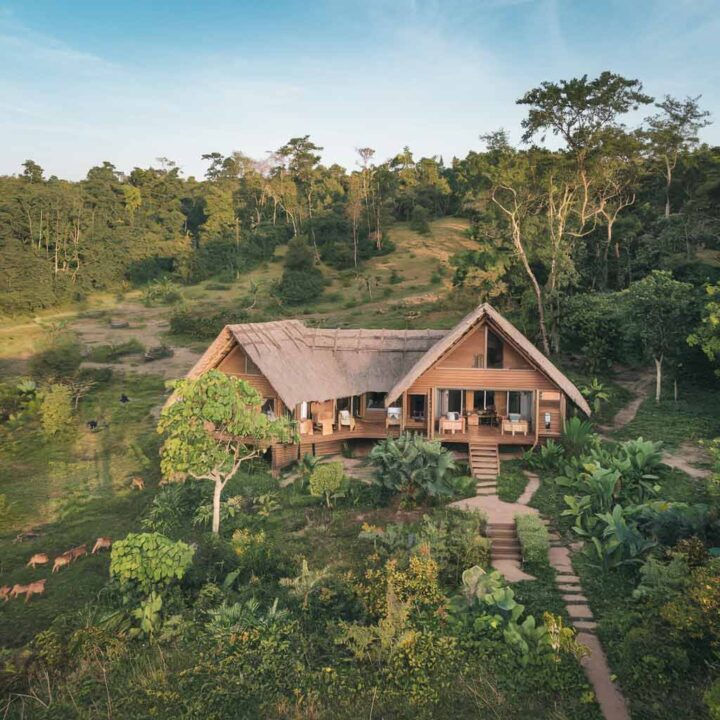
1. Protects Wildlife & Habitats
When you stay at a lodge that supports conservation, you’re helping to protect the landscapes and animals you came to see. Many eco-lodges fund anti-poaching patrols, habitat restoration, and endangered species programs. So, your trip actively contributes to their survival.
2. Supports Local Communities
Sustainable tourism ensures that local people, not just outsiders, benefit from conservation. Many eco-lodges employ local guides, source food from nearby farms, and reinvest profits into villages—providing education, healthcare, and jobs that make communities less reliant on unsustainable practices like poaching or logging.
3. Reduces Your Environmental Footprint
The reality is that travel has an impact. But staying at an eco-lodge minimizes yours. They use less water energy and produce less waste while giving you an authentic, meaningful experience. It’s the best way to enjoy nature without damaging it.
If we want to preserve these wild places for future generations, we need to support the people and places protecting them today.
Tips for Responsible & Sustainable Safari Travel
Even if you choose an eco-friendly lodge, your travel actions still matter. Over the years, I’ve picked up a few simple but powerful ways to make my safaris more ethical and sustainable.
1. Travel Light & Pack Responsibly
Pack reusable essentials—a refillable water bottle, bamboo utensils, cloth bags, and biodegradable toiletries. Avoid single-use plastics because even the best lodges struggle with proper waste disposal in remote areas.
2. Respect the Wildlife
Always follow the golden rule of wildlife watching: Observe, don’t interfere. Keep a respectful distance, never feed animals, and don’t pressure guides to get “closer” for a better photo. You’re too close if an animal changes its behavior because of you.
3. Choose Ethical Safari Operators
Ensure your safari provider follows ethical wildlife viewing guidelines—no off-road driving in sensitive areas, no baiting animals, and no overcrowding at sightings. Responsible operators will always prioritize the animal’s well-being over tourist demands.
4. Reduce Your Carbon Footprint
Safaris often require long drives and flights. Consider carbon offset programs or choosing lodges that invest in reforestation projects. Some places also offer walking or cycling safaris, which are a much lower-impact (and more immersive) way to explore.
5. Support Local & Sustainable Businesses
Eat at local restaurants, buy souvenirs made by local artisans, and book with community-run tour operators. This keeps money within the region and encourages long-term sustainable tourism.
6. Leave No Trace
This should go without saying, but take everything you bring—including trash, plastic wrappers, and non-biodegradable waste. Many wilderness areas have no recycling facilities, so even a single plastic bottle can stay in the environment for decades.
7. Educate Yourself & Spread Awareness
One of the most powerful things you can do is learn and share. Please read up on conservation issues, talk to lodge staff about their sustainability efforts, and share your experiences with others. Awareness leads to action—and action leads to change.
Conclusion
Travel should be about more than just seeing beautiful places—it should be about protecting them. Every eco-friendly safari lodge on this list offers an experience that’s breathtaking but also responsible and meaningful.
I’ve been lucky enough to witness tigers in the wild, elephants crossing rivers, orangutans swinging through ancient rainforests—all while knowing my stay helped, rather than harmed, these incredible places. And that’s what sustainable travel is all about.
If you’re planning a safari in Asia, I hope this guide helps you find a lodge that aligns with your values. When we choose eco-friendly stays, we’re not just travelers—we’re part of the solution.
So, where’s your next adventure? If you’ve stayed at an amazing eco-lodge or have tips on responsible travel, I’d love to hear your thoughts. Let’s keep exploring and protecting this beautiful planet, one journey at a time.
FAQs
1. What makes a safari lodge eco-friendly?
Eco-friendly safari lodges minimize environmental impact while supporting local communities and conservation efforts. They use solar power, rainwater harvesting, sustainable materials, and ethical wildlife tourism practices. True eco-lodges also avoid harmful activities like captive animal experiences or excessive resource consumption.
2. Are eco-friendly safari lodges expensive?
Not always! While some eco-lodges offer luxury experiences, there are also budget-friendly options that prioritize sustainability without the high price tag. Many lodges reinvest profits into conservation, which means your stay directly supports protecting wildlife and local communities.
3. Do eco-lodges provide the same comfort level as regular safari lodges?
Yes! Many eco-lodges offer luxury accommodations with modern amenities like hot showers, comfortable beds, and delicious organic meals. The difference is that these comforts, such as solar-powered electricity, natural cooling systems, and sustainable materials, come with a low environmental footprint.
4. Will I still get good wildlife sightings at eco-friendly lodges?
Absolutely. Many of the best wildlife experiences happen at eco-lodges in protected areas. These lodges follow ethical wildlife-viewing practices, ensuring unforgettable encounters without disturbing the animals.
5. How can I be sure a lodge is truly eco-friendly?
Look for lodges with recognized sustainability certifications (like the Global Sustainable Tourism Council or EarthCheck). Check if they use renewable energy, support conservation projects, and employ local staff. Reading guest reviews and checking the lodge’s environmental policies can also help confirm their commitment to sustainability.
6. What are the best eco-friendly safari lodges in Asia?
Some of the best include:
- Sukau Rainforest Lodge (Malaysia) – Borneo’s top eco-lodge for river safaris.
- Tiger Tops Tharu Lodge (Nepal) – Ethical elephant encounters in Chitwan.
- Cardamom Tented Camp (Cambodia) – Stay with rangers protecting a rainforest.
- Gal Oya Lodge (Sri Lanka) – See swimming elephants on a boat safari.
- Samode Safari Lodge (India) – A luxurious, sustainable retreat in tiger country.
- Waghoba Eco Lodge (India) – Solar-powered comfort in Tadoba National Park.
- Borneo Rainforest Lodge (Malaysia) – A deep-jungle experience in Danum Valley.
7. What should I pack for an eco-friendly safari?
- Reusable water bottles – Avoid single-use plastics.
- Biodegradable toiletries – Protect the environment.
- Neutral-colored clothing – Blends into nature for better wildlife viewing.
- Binoculars & camera – This is for capturing wildlife without disturbing it.
- Insect repellent – Preferably natural and DEET-free.
- Comfortable hiking shoes – For jungle treks and nature walks.
8. How can I be a responsible traveler at an eco-lodge?
- Follow wildlife guidelines – No feeding or disturbing animals.
- Use resources mindfully – Conserve water and energy.
- Support local businesses – Buy from artisans and eat local food.
- Respect the culture – Learn about local traditions and communities.
- Leave no trace – Take all waste with you and avoid plastic waste.
9. When is the best time to visit an eco-friendly safari lodge in Asia?
The best time depends on the country and wildlife you want to see. In general:
- Borneo & Cambodia – Best between March and October (dry season).
- India & Nepal – Best between October to June (cooler months, best for safaris).
- Sri Lanka – Best between February and September (especially for boat safaris).
10. Why should I choose an eco-friendly safari lodge over a traditional one?
Because your stay makes a difference. Eco-lodges offer incredible wildlife experiences while actively protecting the environment. Instead of harming nature, you’re contributing to conservation, community empowerment, and sustainable tourism—ensuring that future generations can enjoy these wild places, too.




